
The Indo-Iranian language family is comprised of languages spoken primarily in Iran, Afghanistan, some former Soviet republics, some areas of Iraq and Turkey, Pakistan, India and Bangladesh. Simply stated, this language family makes up the bulk of languages spoken in central and south-central Asia. This language family is divided into two language sub-families, known as the INDIC sub-family and the IRANIAN sub-families. Below, you will find some examples from each sub-family, as well as a sample from each specific language. (Parentheses demonstrate a language no longer in usage, as some call a 'dead language.') A roman numeral followed by a letter indicates a language that is a descendant of the previously mentioned language with the corresponding numeral.
INDIC ¦------------IRANIAN------------¦
THE INDIC LANGUAGE SUB-FAMILY
Let us now take a look at some of the languages belonging to this group:
I) (Sanskrit)--Many of you probably recognize this ancient language/script as the precursor to languages of the Indian subcontinent, such as those of India and Nepal. Its script is the basis of the written Hindi and Nepali languages of today. As it is technically considered a dead language, it is obviously very much alive today in India, where approximately 900,000,000 people, or roughly one sixth of the world's population, speak Hindi as one of their native tongues. It is also the official language used in Hinduism and in its original text of the Upanishad. Here is an example below, with its translation:

AUM saha naavavatu |
OM! May that Brahman protect us both (Teacher & Disciple);
saha naubhunaktu |
May that Brahman nourish us both;
sahaviirya.n karavaavahai | May
we work in harmony with great vigor;
tejasvi naavadhiitamastu |
May our study be illuminating and fruitful;
maa vidvishhaavahai ||
May we not hate each other.
AUM
Om..
shaa.ntiH shaa.ntiH
Peace, Peace..
shaa.ntiH || Peace.
II) (Prakrit)--Another language of the subcontinent,
Prakrit is said to possibly be a later form and vernacular dialect of the
aforementioned Sanskrit. It was supposedly used by those of the lower
classes, thus it was also considered a popular language. To find
out more about this language, please click on the link below. At
this time, I have no text example available, but as an educated guess,
it is probably very very similar to the Sanskrit script.
http://www.kids.infoplease.com/ce5/CE042045.html
III) (Pali)--This language, although considered dead linguistically, is still used primarily in Theravada Buddhism. One also may assume that the term "Nepali" is derived from the name of this language, as Nepal is a major Buddhist country. More than likely, some of the Nepali language was derived from Pali. Once again, I have no example of the Pali script, but you may find the following resource very helpful: click here.
IV) Gujarati--We have now come to the first
language of the Indic subfamily that is not considered dead, i.e., still
in use. This language is primarily spoken in the region of Gujarat
in northwestern India, near the Pakistani border. Unbeknownst to many,
there are roughly 850-900 languages and dialects spoken within India. There
are many resources on the Internet regarding this language, including this
one. The following is a sample text of this beautiful language
(no translation), and as you will see, many of the Indian language scripts
look very similar:
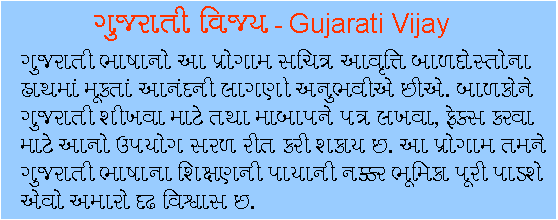
V) Marathi--Another important language
of the Indian subcontinent, this is the official language of the Maharashtra
region in north central India. The primary city of the region is
Mumbai (Bombay), therefore the language has numerous speakers due to the
large population. Follow this
link for more information on this region.
Here is a textual example of the Marathi language (no translation
available):

VI) Hindustani--This language is difficult to describe, due to the nature of different classifications. The best description that I have found is that Hindustani is considered the SPOKEN form of Hindi and Urdu (see descriptions of these two languages below). As a result of this description, it is spoken throughout the Indian subcontinent, and really has no written text, as it is considered a spoken language. To discover more about Hindustani, check out the following site: http://www.kids.infoplease.com/ce5/CE023958.html. Or, check out "hindustani" by using the search engine of your choice.
VII) Hindi--One of the official languages of
India as a whole, it is one of the most widely-spoken languages on Earth.
This language, derived from Sanskrit, is used by all Indians in order to
communicate, as the roughly 1,000 languages and dialects of India make
effective communication difficult. Many links to Indian websites
and numerous language websites will provide you with more info on this
universal language. Here is a textual example (no translation) of
the Hindi language, and of course, it is very similar to other languages
of the subcontinent:
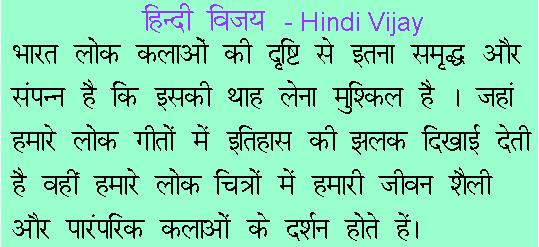
VIII) Urdu--This is the official language of Pakistan, now an independent nation, but once an Islamic state of India. Due to its ties with India, Urdu has its origins within the Indic linguistic subfamily. Yet, it must be noted that although the Urdu language is similar to Hindi when spoken (see Hindustani), its script is written by means of the Arabic alphabet. Due to its Islamic roots, it has also adopted many words from Arabic and even Persian. Like Arabic, this language is also read from RIGHT to LEFT, unlike the other Indic languages. The following are examples of the Urdu language:
![]()
![]()
IX) Bengali--This language is the official language
of Bangladesh, with a population of roughly half the United States, and
it is also spoken in northeast India near Bangladesh, including the city
of Calcutta. Bangladesh is also a former Indian province. Due
to the population explosion in this part of Asia, this language ranks among
the top ten languages spoken in the world. To discover more about
the Bengali language and Bangladesh, click
here. The following is an example from the Bengali language (no
translation):
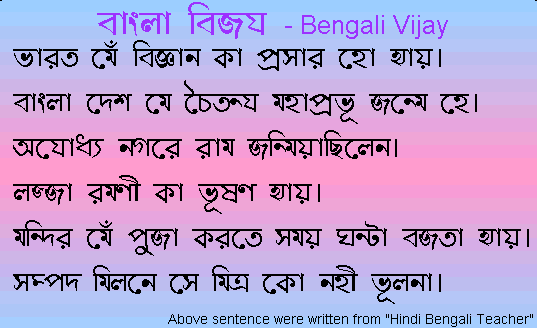
X) Bihari--I have had some difficulty finding some information on this language up to this point, but I do know that it is a Modern Indic vernacular language. Technically, Bihari is not a language itself, but a collective name of three separate languages: Bhojpuri, Maithili and Magahi. These languages are spoken primarily in the region of Bihar, in northeast India. I would suspect that its script is also very similar to the previously mentioned Indic languages. To find out more on this language, click on this encyclopedic link: http://www.funkandwagnalls.com/encyclopedia/low/articles/i/i012000442f.html
XI) Sindhi--This language is quite similar to
Urdu (see above) because it is also written with the Arabic alphabet, and
its original base is Sanskrit, with words borrowed from Arabic, Persian
and Dravidian (a subcontinent language group, not Indo-European).
The reason that it is so similar to Urdu is because the region where it
is the main language, Sindh, is a region of present-day Pakistan.
It was an independent state for quite a long time, but after the British
occupation of India, and Pakistan seceded, Sindh had two choices: to join
India OR Pakistan. Due to the Islamic majority, it chose to join
Pakistan. To find out more about the Sindh language and culture,
click
here. I have an example of the Sindh alphabet below (similar
to that of Urdu, but with 7 additional sounds):
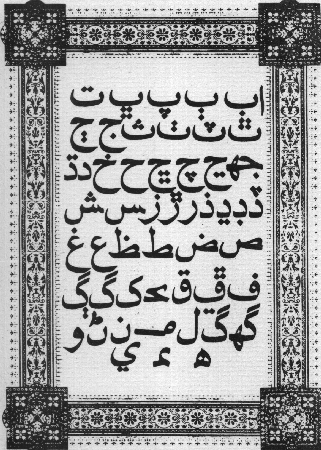
XII) Bhili--Once again, I have found a language on which it is difficult to find a good description thus far. It is spoken by the Bhil Bhilbari people of Eastern India, and it has a similar script to the other Sanskrit-based languages, most likely. To find out more, research this language on any search engine of your choice. I'm sorry to have a disappointing description of this language.
XIII) Rajasthani--This language is widely spoken in northwest India in the state of Rajasthan. The language is similar to other Sanskrit-based subcontinental languages. I have really no other information about the language, including a script example. To find out more about Rajasthan, use your preferred search engine and type in the word "Rajasthan."
XIV) Panjabi--This is the language spoken by
the inhabitants of the well-known region of Punjab, in northwest India.
This region is also known as the region where the "Aryan" culture began.
As it has been divided between India and Pakistan like other states in
the region, there has been much conflict. Most of you probably know
Punjab as the home of the religion called Sikhism, a religion with very
strong traditions, many of them militaristic. The languages is also
very similar to other Sanskrit-based languages, and below, I have a furnished
an example of its script:
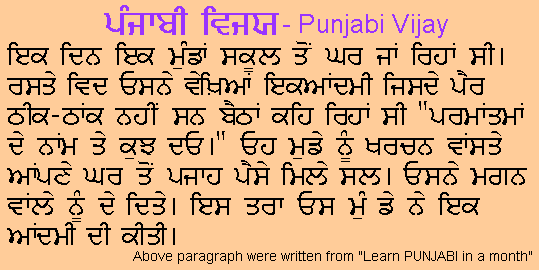
XV) Pahari--Unfortunately, as the last Indic language I have to describe, I have no description at this time. I cannot seem to find much information on the language or the region of India in which it is spoken. Please utilize your search engine to find any more information regarding this subject. If you have any suggestions or ideas, please e-mail them to me.
--To conclude the Indic sub-family section of this page, I would
like to direct your attention to this page.
It will give you an idea of how many languages are spoken on the Indian
subcontinent. There are ONLY 325 languages listed on this page (supposedly-I
have not counted them myself), but even this magnanimous number of languages
makes up about 1/3 of the languages and dialects spoken in India today.
THE IRANIAN LANGUAGE SUB-FAMILY
Here are a few examples of the languages belonging to this subgroup:
I) (Avestan)--This 'dead' language, along with
its successor language, Pashto, makes one branch of the Iranian sub-family.
This language is best known as the official language of Zoroastrianism,
a religion that still exists today that was founded in Ancient Persia,
today known as Iran. You will find much info about this language
in the texts of Zoroastrianism, as these texts are practically the only
source of this ancient language. Below is a textual example of this
language:

I) A) Pashto--This language, along with its
sister language, Dari, is one of the official languages of Afghanistan.
It is also spoken in some portions of Pakistan near the Afghan border.
This language is similar to Persian (Farsi), and it is derived from the
ancient language of Avestan. Like Urdu and Dari, Pashto is written
in Arabic script, and is read from left to right. In addition to
the normal Arabic alphabet, there are a few extra sounds/letters added.
There are many web resources on the Pashto language. Just type "Pashto"
into your search engine field. Below is an example of Pashto:
 (BBC World Service)
(BBC World Service)
II) (Old Persian)--Along with the aforementioned
Avestan language, Old Persian was the first language in the development
process of Modern Persian (Farsi). Old Persian is written in cuneiform,
and is most commonly found in ancient inscriptions of the Persian kings
of the Achaemenid dynasty. Below is an example of some Old Persian
text:

II) A) Persian (Farsi)--The most well-known
language of the Iranian sub-family, the Persian language is the official
language of present-day Iran, and it is also spoken in parts of Afghanistan
and Tajikistan. It is written in Perso-Arabic script, i.e., the Arabic
alphabet which has been expanded with many other characters/sounds/letters.
Due to the strongly conservative Islamic regime present in Iran, the language
is commonly associated with Shi'a Islam. There are many resources
on the Internet for this language. Search under "Persian" or "Farsi."
Below are titles of two Iranian newspapers, in Farsi:


II) B) Kurdish--This ancient language, still in usage today, also stems from Old Persian. This is the language of the Kurds, of whom the majority live in a region called Kurdistan, which covers portions of several nations, such as Iraq, Iran, Syria, Armenia and Turkey. The Kurds are an ethnic group that has long been looked down upon by surrounding nations, but its culture is very vibrant and its population numbers around 30 million. The language is written in Arabic script, but the sample that I have below, from a poem, is written in the Latin alphabet:
Min navê xwe kola li bircên Diyarbekir
Min navê xwe kola li bircên
Diyarbekir
Gava ku stêrk
Li esmana stûxwar,
Gava ku
ney û blûr û tembûr
Û dehol û zirna
sar
bûn.
Û cobar
Ne dixu^sin di nivînên xwe
de seraser
II) C) Ossetic--This Iranian subfamily language is written in the Latin alphabet, but previously was written in the Armenian alphabet. This language is spoken primarily by descendants of the Alans, who live in present-day Ossetia, which is partially within the Republic of Georgia and partially within Russia. The language has two dialects, Iron and Digor. At this time, I am unable to furnish a textual example of its script. Use your favorite search engine to discover more on this subject.
II) D) Baluchi--Another Iranian subfamily language, is spoken primarily in eastern Iran and portions of Pakistan. I am unaware of its script. It is most closely related to Kurdish, and more distantly related to Farsi. There are a few resources on the Internet that can explain Baluchi in a bit more detail.
III) (Scythian)--This language, 'dead' if you will, was used by the Scythians, a pastoral nomadic group who wandered across the great plains and fields of central and western Asia. They had no written language, therefore I have no example for you. According to the historian Herodotus, they also ruled from the Caucasus Mountains to the Carpathian Mountains of central Europe. To find out more about the Scythians, click here.
--I would like to thank you for taking the time and
effort to peruse this language information page. Keep in mind that
much of this information is very general and basic, due to convenience
and easy access. Also keep in mind that, in most cases, each language
has many dialects. In addition to this, there are literally hundreds
of other languages that may be counted amongst each group, sub-family,
etc. Therefore, do not take this information for granted as being
a description of ALL languages. That would be, well, not impossible,
but something that would require much more time than I have. Feel
free to check out the other language pages, too!